Things to do in Frankfurt
Frankfurt has some fascinating historical attractions, while there's also a lot to see for the trendy traveller hungry for fashion and contemporary thrills. Sightseeing in Frankfurt is best done in the summer months, when the weather is warmer and the days longer. But as the city boasts some truly wonderful museums, galleries and other indoor attractions, Frankfurt is essentially a year-round destination.
For history buffs, some of the best Frankfurt attractions include the Well of Justice fountain in Römerberg Square, dating back to 1541, and the Eschenheimer Turm, a medieval tower from the 15th century. The Historical Museum exhibits a range of impressive artefacts from the Middle Ages, while the Goethe-Haus is where writer Johan Wolfgang von Goethe was born in 1749.
Other popular cultural sites in Frankfurt include the Städel Gallery, which houses works by Renoir, and the Museum of Sculpture, which boasts beautiful pieces from ancient Greece and Rome. Travellers should visit the German Film Museum (Deutsches Filmmuseum) to watch one of the classics from its enormous collection, or perhaps stroll through the vast plant kingdom found in Frankfurt's Botanical Gardens. Those travelling with kids in Frankfurt will find lots of family-friendly attractions too, including the wonderful Frankfurt Zoo and the Senckenberg, a natural history museum.
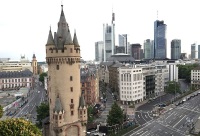
Eschenheimer Turm
The Eschenheimer Turm is one of the few remaining towers of Frankfurt's medieval fortifications. The 154-foot high (47m) Gothic tower was built in the 15th century, and was one of …
Eschenheimer Turm
The Eschenheimer Turm is one of the few remaining towers of Frankfurt's medieval fortifications. The 154-foot high (47m) Gothic tower was built in the 15th century, and was one of approximately 60 towers surrounding the city. The tower is both the oldest and the most unaltered building in the largely reconstructed city centre and is a striking Frankfurt landmark. The tower has eight levels and four smaller side-turrets, looking like something out of a fairytale. Now a popular tourist attraction in Frankfurt, there is a restaurant and bar at the base of the Eschenheimer Turm that offers a good place to relax and unwind after a day of seeing the sites.
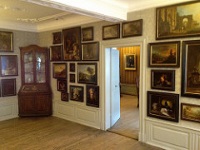
Goethe-Haus
The birthplace of Germany's iconic poet and writer, Goethe-Haus is now a shrine to Johann Wolfgang von Goethe's memory and preserved as an example of how the well-to-do lived in Fr…
Goethe-Haus
The birthplace of Germany's iconic poet and writer, Goethe-Haus is now a shrine to Johann Wolfgang von Goethe's memory and preserved as an example of how the well-to-do lived in Frankfurt in the late Baroque era. The house, which is a reconstruction because the original was destroyed during World War II, consists of two neighbouring half-timbered houses in Grosser Hirschgraben and is situated next to the Goethe Museum, which contains a huge library of books, documents and graphics. Even if visitors aren't particularly interested in the writer, Goethe-Haus provides welcome insight into 18th-century Frankfurt. All the rooms are beautifully decorated and furnished, and many of the artefacts have recorded stories and associations from the Goethe family.
Website www.goethehaus-frankfurt.de
Frankfurt Botanical Gardens
The well-ordered and interesting Botanical Garden in Frankfurt is administered by the university and is a beautiful place to while away a few hours. The gardens are designed to tak…
Frankfurt Botanical Gardens
The well-ordered and interesting Botanical Garden in Frankfurt is administered by the university and is a beautiful place to while away a few hours. The gardens are designed to take visitors on a journey through different areas of the plant kingdom, from the hardwood forests of North America to the vast savannahs of Africa. The gardens cover more than eight hectares (20 acres) and contain more than 6,000 different botanical species, from exotic rainforest flowers to European weeds. There is a playground in the gardens to amuse little ones, as well as miniature golf and a cafe.
Website www.botanischergarten-frankfurt.de
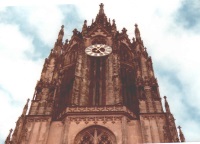
St Bartholomew Cathedral
St Bartholomew's Cathedral dominates the Frankfurt skyline with its imposing 311-foot (95m) spire, contrasting sharply with the modern skyscrapers in the downtown area. The cathedr…
St Bartholomew Cathedral
St Bartholomew's Cathedral dominates the Frankfurt skyline with its imposing 311-foot (95m) spire, contrasting sharply with the modern skyscrapers in the downtown area. The cathedral was built in the 14th and 15th centuries, and has seen the crowning of kings and emperors. The architecture is traditional Gothic, with an interior boasting artistic treasures and striking carvings. The winding spiral stairs leading to the tower bells make for some spectacular views, with informative booklets educating guests on its history and the artefacts down below. As the cathedral is still an active place of worship, it's partially closed to tourists at times for services.
Website www.dom-frankfurt.de
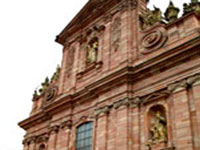
Heidelberg
The historic university town of Heidelberg is a city of music and romance along the Neckar River. One of the few German cities that escaped relatively unscathed from World War II, …
Heidelberg
The historic university town of Heidelberg is a city of music and romance along the Neckar River. One of the few German cities that escaped relatively unscathed from World War II, it boasts numerous Medieval and Renaissance buildings, including some beautiful historical churches and university structures from 1386. A good way to enjoy scenic views of Heidelberg is along the Philosopher's Walk, a path alongside the Heiligenberg. A vibrant atmosphere permeates Heidelberg, particularly in the student quarter with its narrow streets and lively pubs. The weather in Heidelberg is famously sunny and warm compared to much of Germany, and this is a major draw for the millions of tourists who visit each year.
Website www.heidelberg.de
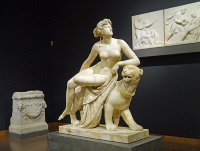
Liebieghaus
Built for a baron in 1896, the Liebieghaus is today the home of Frankfurt's Museum of Sculpture. It almost looks like a castle, with its beauty and majesty adding to a medieval atm…
Liebieghaus
Built for a baron in 1896, the Liebieghaus is today the home of Frankfurt's Museum of Sculpture. It almost looks like a castle, with its beauty and majesty adding to a medieval atmosphere; exhibits cover ancient times from Sumeria and Egypt to Greece and Rome, as well as Baroque, Rococo and Renaissance periods. There are some 5,000 pieces in the collection, but the museum somehow still feels intimate and is usually less crowded than other big art institutions in Frankfurt. The Liebieghaus also puts up some great temporary exhibits showcasing modern sculptors, while tours and audio guides are both available.
Website www.liebieghaus.de
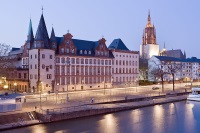
Historical Museum (Historisches Museum)
The Historical Museum has many permanent exhibitions featuring objects and works of art ranging from the Middle Ages to the present day. The museum's changing exhibitions cover a r…
Historical Museum (Historisches Museum)
The Historical Museum has many permanent exhibitions featuring objects and works of art ranging from the Middle Ages to the present day. The museum's changing exhibitions cover a range of themes such as cultural history, art history and general history. Collections feature examples of gold and silver crockery and jewellery; pottery and porcelain; paintings and photographs; and scaled-down models of the Altstadt (Frankfurt old town) at various periods of development. The museum is useful for giving visitors an idea of how different Frankfurt looked before the damage of World War II. The Children's Museum, which lies adjacent to the Historical Museum, has a variety of special offers and exhibitions for youngsters of all ages.
Website www.historisches-museum.frankfurt.de
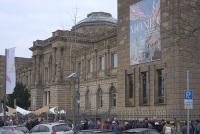
Städel Gallery
Frankfurt's most important art gallery is the Städel Gallery, which contains a fantastic collection of many European schools of painting and a revolving calendar of high-quality t…
Städel Gallery
Frankfurt's most important art gallery is the Städel Gallery, which contains a fantastic collection of many European schools of painting and a revolving calendar of high-quality temporary exhibitions. The first floor features the works of German painters of the 19th and 20th centuries, as well as famous French Impressionists such as Renoir and Monet. The second floor offers an outstanding collection of Flemish Primitives, 17th-century Dutch artists and 16th-century German masters such as Dürer, Grünewald, Memling and Elsheimer, with one of the most prized paintings being Jan van Eyck's Madonna (1433).
English language tours are available, as are audio-guides for visitors who'd prefer to explore on their own. Those who have additional time, can enjoy workshops, talks and a research library. A café and bookshop are also located on-site.
Website www.staedelmuseum.de

Frankfurt Zoo
Located in Ostend and almost completely destroyed in World War II, the Frankfurt Zoo has grown to become one of the most popular in Europe. It's home to more than 3,200 animals fro…
Frankfurt Zoo
Located in Ostend and almost completely destroyed in World War II, the Frankfurt Zoo has grown to become one of the most popular in Europe. It's home to more than 3,200 animals from about 600 species, and is renowned for keeping them in environments that closely resemble their own natural habitats. A major drawcard for the zoo and one of its most unique features is Grzimek House, which is home to nocturnal animals. Other popular animals include tigers, penguins, rhinos, lions, crocodiles and hippos, as well as a vast collection of fish, insects and reptiles.
Website www.zoo-frankfurt.de
Senckenberg Museum of Natural History
One of the biggest natural history museums in Germany and housed in a UNESCO World Heritage Site, the Senckenberg Museum of Natural History features extensive exhibits on the biodi…
Senckenberg Museum of Natural History
One of the biggest natural history museums in Germany and housed in a UNESCO World Heritage Site, the Senckenberg Museum of Natural History features extensive exhibits on the biodiversity and evolution of life on Earth. A popular attraction is the fascinating palaeontology exhibit, which showcases fossils that date back over 50 million years; visitors will find fantastic display of dinosaurs that range from tiny trilobites to t-rex. There is also a floor dedicated to stuffed animals, including the world's largest collection of stuffed birds. English language guides are available, as are audio guides for visitors who'd prefer to explore the institution at their own pace.
Website www.senckenberg.de
The Fairy Tale Road
The German Fairy Tale Road follows a meandering 370-mile (595km) route through charming villages and gingerbread houses, lush forests and well-preserved medieval towns. It traces t…
The Fairy Tale Road
The German Fairy Tale Road follows a meandering 370-mile (595km) route through charming villages and gingerbread houses, lush forests and well-preserved medieval towns. It traces the path of the Brothers Grimm, famous storytellers who collected the folktales that inspired characters such as Sleeping Beauty, Little Red Riding Hood, and Hansel and Gretel.
Starting in their birthplace of Hanau, visitors explore attractions such as the Brothers Grimm National Monument in the town square, the Puppet Museum at Williamsbad, the Marienkirche and the Philippsruhe Palace. Further on, the town of Kassel is home to the Brothers Grimm Museum. From there, it's on to Hameln, the famous town of the Pied Piper, and the Fairy Tale Museum in nearby Bad Oeynhausen. The road ends in the town of Bremen, home of both the mythical Little Nienburg Girl and the very real Rathaus, a vibrant marketplace filled with town musicians and the famous Ratskeller Restaurant.
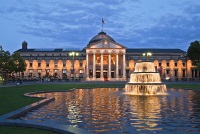
Wiesbaden
Situated in a valley between the Rhine River and Taunus Mountains, charming Wiesbaden is arguably Germany's favourite spa resort. Once enjoyed by the Ancient Romans, it offers 26 s…
Wiesbaden
Situated in a valley between the Rhine River and Taunus Mountains, charming Wiesbaden is arguably Germany's favourite spa resort. Once enjoyed by the Ancient Romans, it offers 26 springs averaging around 105F (41C). Wiesbaden is also a cultural centre, its events focusing around the major Kurhaus concert hall complex. A walking tour is a great way to take in the historical and cultural attractions of Wiesbaden, with Wilhelmstraße replete with enticing boutiques and striking architectural landmarks. Another great activity is to catch the view from the Greek Orthodox Church on the hill, reached by the Nerobergbahn, a water-powered train that has been running since the late 1800s.



